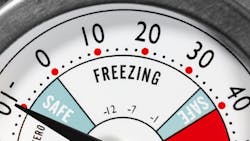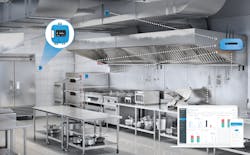What Does LoRaWAN Have to Do with Your Next Cheeseburger?
This article is part of the TechXchanges: LoRaWAN and The Internet of Things (IoT).
What you’ll learn:
- How LoRaWAN overcomes traditional challenges to using wireless sensors in food safety.
- Battery efficiency is a critical factor in wireless networks.
- How ADR optimizes links between sensors and network gateways.
The next time you’re getting a burger at your local pub, think about the increasing role that low-power, long-range wireless technology plays in making sure every part of your meal is delicious, fresh, and safe.
Given the massive growth in global deployments of LoRaWAN technology, there’s a good chance that the technology played a role in ensuring that the lettuce in your burger is crisp and the chips/fries are perfect. It may have also ensured that beef or veggie patties stayed at the right temperature throughout the supply chain as well as in the restaurant’s walk-in cooler. Your friends and family may roll their eyes at this information, but it’s a huge success story about how wireless engineers are solving real-world challenges with LoRaWAN.
Temperature Monitoring Essential in Food Distribution
Temperature and humidity are critical for food distribution and in the food-service industry at large. Storing foods in the right conditions enables the food to get to people’s plates in ways that ensure freshness and safety (Fig. 1).
Freshness is straightforward. No one wants a limp piece of lettuce on their burger, and there’s far less waste for the food and restaurant industries when they keep food fresh. Not doing so costs the industry billions each year according to the Food and Agriculture Organization of the United Nations.
But food safety is also a huge reason for investments in temperature-monitoring systems. Foodborne illness affects millions of people annually in the U.S. alone, and a common factor causing foodborne illness is failure to achieve or maintain appropriate temperatures for food storage. As an example, frozen foods like veggie patties or ground beef whose temperature rises above freezing for even a short amount of time represent a major safety risk.
Wireless Sensors: Challenges and Rewards
Wireless sensors can dramatically improve food safety and freshness by conducting continuous monitoring of factors like temperature and humidity at each step in a food’s journey from farm to a customer’s plate. But there have traditionally been major challenges to using wireless sensors for both legs of the food’s journey: during its movement through the cold supply chain, and then when it’s being stored and prepared in the food-service environment.
The challenges are very different in each of those phases:
- Distribution networks move food over vast distances, often through geographic areas where telecommunications infrastructure is sparse or unreliable. This deprives most connectivity technologies of their primary means of delivering updates, creating blind spots that undermine the ability to monitor food-safety factors using wireless sensors traveling with the food products.
- Once the food arrives at a restaurant, it’s stored and prepared in a harsh RF environment that creates massive performance issues for most connectivity technologies. Appliances with metal surfaces, walk-in coolers with thick insulated freezer walls, extensive use of concrete construction, and other factors are major obstacles to using wireless sensors everywhere that cooked and uncooked food is in the restaurant.
LoRaWAN Helps Overcome Sensor Issues
Those conditions are major challenges for other connectivity technologies, but they align with the current capabilities of LoRaWAN as well as enhancements to LoRaWAN that are in the technology’s roadmap. That’s why LoRa technology is becoming a go-to technology for engineering teams designing systems for cold supply chains and food service.
For those of you unfamiliar with the LoRaWAN specification, it provides secure, bidirectional data transfer and communications with IoT networks over very long distances—up to 10 miles—even in areas where telecommunications infrastructure doesn’t exist. That range can be extended indefinitely with the addition of inexpensive LoRaWAN relays at 10-mile intervals, depending on the topography.
LoRaWAN also performs incredibly well in difficult RF environments, readily penetrating stainless steel, heavy insulation, and concrete construction of commercial kitchens (Fig. 2). In environments where other technologies like Bluetooth struggle, LoRaWAN achieves excellent data-transfer performance even when transmitting and receiving data through these materials—an invaluable benefit for environments like restaurant kitchens.
Battery efficiency is another huge advantage of LoRaWAN that lends itself to the needs of cold supply chains and food service. In most cases, nodes can operate for years without requiring a battery change. LoRaWAN nodes are also inexpensive compared to other technologies, which is particularly valuable for the food-related applications discussed above. They often involve high numbers of sensors in shipments, in storage warehouses, and in food-service environments.
LoRaWAN is also highly scalable and highly interoperable, compatible with both public and private networks for data backhaul and bidirectional communications. As mentioned above, one of its best qualities is the ability to perform in harsh environments, which requires good radio propagation and penetration capabilities or resilience against interference, conditions that are common factors for consideration when transporting food across the globe.
The primary limitation that LoRaWAN does have is data throughput, which makes it less than ideal for high-data-rate applications. However, LoRaWAN works very well for sensor networks that generate small packets of periodic or event-driven data sent by the network back to a central location. This is exactly the type of data transfer that’s involved with cold supply-chain monitoring and food-service environments, so limited data throughput isn’t an issue for this use case.
LoRaWAN Implementation: A Simpler Task via “Self-Discovery”
Engineers who haven’t worked with LoRa before may assume that a high level of RF expertise may be needed for the initial setup of a network and for each adjustment—as is often required with other IoT technologies. In comparison, LoRaWAN uses self-discovering devices to simplify deployments.
To set up each segment of the network, a central gateway is placed in a location free of major physical obstructions, and then the stick-and-go sensors are put in place wherever they’re needed for food monitoring. Once the gateway is turned on, the network self-discovers the sensors, and the network is off and running doing what it was designed to do. As sensors are moved to new locations, the network simply adjusts to the new location without any complex RF re-engineering required.
Take Advantage of Adaptive Data Rate and the Cloud
One highly useful attribute of LoRa that engineering teams should be aware of is the ability to use adaptive-data-rate (ADR) frequency adjustments to automatically optimize the connection between sensors and LoRaWAN gateways. ADR monitors the signal-to-noise ratio and adjusts frequency to maintain a strong connection and optimize performance.
Essentially, this feature utilizes machine learning (ML) to enable sensors and the gateway to learn about their environment, adapt to the environment, and maintain strong connectivity without the need for intervention and management by an engineer. This attribute of LoRa isn’t widely known, but it’s a key feature that makes it possible to deploy LoRaWAN-based IoT networks that operate without the need for complex RF engineering of the initial implementation or ongoing operations.
Cloud integration is another thing that engineering teams should think about early in their planning process for a LoRaWAN device. Every LoRaWAN network requires a LoRa network server, which provides the foundation for effective management of the IoT devices, gateways, and applications.
Engineering teams often prefer hosted solutions that minimize the organization’s need to build out and maintain on-premises IT systems. Experienced providers of hosted LoRaWAN can help customize a cloud solution for your implementation, but discussing this server strategy early is key to avoiding delays later in the process.
It’s plain to see that LoRaWAN is the gold standard when it comes to technology that enables food safety. LoRaWAN may not be on the menu at your local pub, but it may make the next cheeseburger you order the best one you’ve ever had. Bon appétit!
Read more articles in the TechXchanges: LoRaWAN and The Internet of Things (IoT).
About the Author
Senthooran Ragavan
Senior Product Manager, Laird Connectivity
Senthooran Ragavan is the Senior Product Manager for IoT at Laird Connectivity, which provides a full range of modules, antennas and IoT devices that simplify the process of using embedded processing and wireless technology. In this role at the company, he oversees development of solutions utilizing low-power connectivity technologies such as LoRaWAN and works with companies around the world for their wireless product development initiatives.
Senthooran has 10 years of experience in the embedded engineering and wireless design industry. He earned his Bachelor of Engineering from the University of Hertfordshire, and is pursuing a Master’s degree in Business Administration from the University of Essex.


